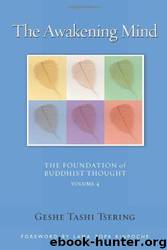The Awakening Mind, Volume 4: The Foundation of Buddhist Thought by Geshe Tashi Tsering & Lama Zopa Rinpoche

Author:Geshe Tashi Tsering & Lama Zopa Rinpoche
Language: eng
Format: azw3
Tags: Psychology, Spirituality, Emotions, General, Religion, Buddhism, Rituals & Practice, Tibetan
ISBN: 9780861715107
Publisher: Wisdom Publications
Published: 2008-08-05T01:56:21+00:00
The Combination of the Two Methods
Both the practices of seven points of cause and effect and equalizing and exchanging oneself with others originally came from India. Chandrakirti, Kamalashila, and Asanga wrote on the seven points of cause and effect, whereas masters such as Nagarjuna and Shantideva used equalizing and exchanging oneself with others while hardly mentioning the seven points. In a sense these were two separate lineages.
When Atisha came to Tibet, he taught both methods together. However, there is no written record available by him combining the two methods, nor are there clear instructions from other masters such as Lama Tsongkhapa. It was only much later that teachers wrote explicitly on how the two methods could be combined.
Which of the three methods we use is our choice and depends more on its suitability to each individual practitioner than on which is superior. For many of us, both of the more traditional methods present difficulties. Perhaps starting with the seven points does not allow us to reach bodhichitta, whereas starting with equalizing does not work because it is unable to trigger the emotional commitment needed. This is where combining the two methods can be quite skillful.
In combining the two methods, there are different systems, but I will use the eleven-step method explained by Pabonka Rinpoche in Liberation in the Palm of Your Hand.45 The steps that combine these two techniques are:
1. generating equanimity (prerequisite to both methods)
2. recognizing all beings as having been one’s mother (seven point)
3. recollecting their kindness (seven point)
4. resolving to repay that kindness (seven point)
5. equalizing oneself with others (equalizing and exchanging)
6. reflecting on the disadvantages of the self-cherishing thought (equalizing and exchanging)
7. reflecting on the advantages of the thought cherishing others (equalizing and exchanging)
8. taking, involving concentration on compassion (both methods)
9. giving, involving concentration on love (both methods)
10. developing special intention (seven point)
11. generating the mind of enlightenment (the result—seven point)
Download
This site does not store any files on its server. We only index and link to content provided by other sites. Please contact the content providers to delete copyright contents if any and email us, we'll remove relevant links or contents immediately.
The Way of Zen by Alan W. Watts(6295)
Ego Is the Enemy by Ryan Holiday(4972)
The Art of Happiness by The Dalai Lama(3855)
The Book of Joy by Dalai Lama(3714)
Why Buddhism is True by Robert Wright(3293)
Spark Joy by Marie Kondo(3093)
Shift into Freedom by Loch Kelly(3035)
Happiness by Matthieu Ricard(2892)
A Monk's Guide to a Clean House and Mind by Shoukei Matsumoto(2789)
The Lost Art of Good Conversation by Sakyong Mipham(2447)
The Meaning of the Library by unknow(2397)
The Third Eye by T. Lobsang Rampa(2175)
The Unfettered Mind: Writings from a Zen Master to a Master Swordsman by Takuan Soho(2164)
Red Shambhala by Andrei Znamenski(2075)
Anthology by T J(2049)
The Diamond Cutter by Geshe Michael Roach(1959)
Thoughts Without A Thinker: Psychotherapy from a Buddhist Perspective by Epstein Mark(1902)
Advice Not Given by Mark Epstein(1769)
Twilight of Idols and Anti-Christ by Friedrich Nietzsche(1766)
